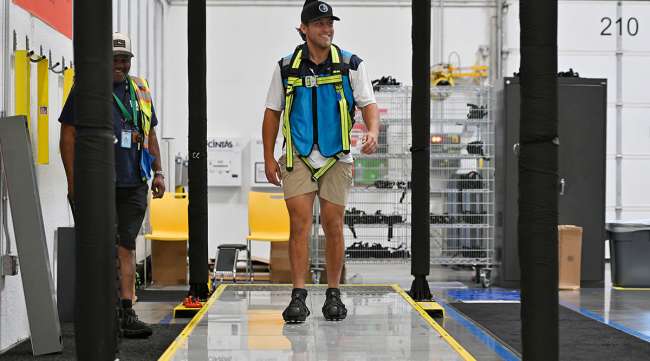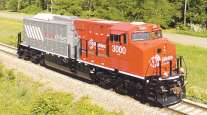Amazon Delivery Drivers in Denver Undergo Unique Training

[Stay on top of transportation news: Get TTNews in your inbox.]
Before an Amazon delivery driver ever drops a package on someone’s doorstep in metro Denver, they have likely gone through a three-day course developed locally, one that could eventually serve as a model of delivery driver training across the country.
The Last Mile Delivery Academy is in unincorporated Adams County, Colo., in a former distribution center. It has classrooms, virtual reality simulators and an indoor driving course, complete with facades of porches and parking lanes.
All of it is designed to help drivers deliver packages more efficiently and safely.
“We have trained 6,200 drivers since opening in March 2022, and we plan to train 2,000 more in the next several weeks,” said Terry Bailey, a program manager, during a tour of the academy Aug. 24.
Drivers spend the first day at the academy in classrooms and working through virtual reality simulations of scenarios that could come up, including de-escalating confrontations with customers, handling hostile dogs and traversing icy sidewalks.
The second day involves driving vans around an indoor track, complete with porch facades, with a trainer sitting nearby. The third day involves going out on the streets with a trainer.

Ryan Manthir of Shell Global Solutions and Michael Grahe of Navistar discuss the future of the internal combustion engine. Tune in above or by going to RoadSigns.ttnews.com.
“Among Denver-area delivery drivers who have completed the Last Mile Delivery Academy course, there was an average 10% improvement among safe and distraction-free driving rates, road incidents and dog incident rates in the first 16 days alone compared to the same quarter last year,” said Nissa LaPoint, an Amazon spokeswoman.
But the biggest reduction has come in slip and fall accidents, which are down by 50% for drivers who complete the course, LaPoint said.
The Slips, Trips and Falls Training simulator has a slick floor that mimics ice when sprayed down with a mixture of water and soap. Drivers attach a harness and walk across a dry course and then a slippery one. They are trained to take little steps and to look forward with their backs straight rather than hunching down to look at the slick surface.
Once trainees are able to master walking the slick course empty-handed, they are given a package. Trainers will sometimes create distractions, and a curb and other obstacles can be added.
Another taken-for-granted behavior involves getting in and out of the delivery vans, which can occur up to 100 times a day. An egress simulator shows the impact when a driver steps quickly out of a truck without grabbing a handrail.
Want more news? Listen to today's daily briefing above or go here for more info
An exit that might generate 400 pounds of pressure on the legs can be reduced to 250 pounds by grabbing a handrail and creating a third point of contact, said Albert DiPasquale, a program manager at the school. Having drivers see the force measured on a scale drives the point home and helps change behaviors.
On the driving course, trainees learn how to parallel park, do a three-point turn, make a serpentine turn and follow the proper parking sequence. Trainers have struck out on finding a mechanical dog to chase the trainees. The next day, they are taken out for a real-world test run.
The academy can handle up to six groups of 15 drivers each, and it is extending its days of operations ahead of a surge in hiring by Amazon’s delivery service partners for the holiday season.
“I was really happy to see the centralized training,” said William Boyd, owner of Alpha Zulu Logistics, which delivers in Aurora and Broomfield, Colo.
Before the academy’s launch last year, driver training happened primarily at Amazon distribution centers. It was heavily focused on online instruction without a lot of hands-on training or scenario training, Boyd said.
“Before, we took it for granted that a driver knows how to walk and carry something. We just made the assumption that someone can get into one of these vans and maneuver it,” he said. “There is technique involved.”
Boyd notes that the average age of the 160 workers at his company skews older at 35. And while some have experience making deliveries, many come from different industries and careers, and some are near retirement age.
“It helps to set the foundation. It brings an element of professionalism,” he said.
Amazon.com Inc. ranks No. 9 on the Transport Topics Top 100 list of the largest private carriers in North America.
Distributed by Tribune Content Agency, LLC




